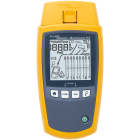The Future Demands More Power
For over two decades, cable plants have supported Power over Ethernet (PoE). While early PoE deployments only needed to support up to 30 Watts (W), more devices today require four pair PoE capable of delivering higher levels of power, including the latest 802.11 Wi-Fi access points (WAPs), digital displays, laptops, LED lighting, and more. This article is an overview of PoE-related topics.
Contents
- What Is Power over Ethernet?
- What Is PoE Used For?
- How Does PoE Work?
- What Voltage Power Is PoE?
- What Are the Benefits of PoE?
- What Are the Standards for PoE?
- What Are the Different Classes of PoE?
- What Are the Cabling Requirements for PoE?
- How Is PoE Tested?
- Choosing the Right Tester for PoE Troubleshooting
- Keep Learning
What Is PoE?
Power over Ethernet (PoE) is a type of Class 2 low-voltage direct current (DC) power that is delivered from power sourcing equipment (PSE), such as a network switch, over balanced twisted pair cabling (such as Category 6A, 6, and 5e). PoE power is delivered simultaneously with data and control information to networked IP-based powered devices (PDs).
What is PoE Used For?
PoE power is used to run a wide variety of networked devices, including IP clocks, VoIP phones, surveillance cameras, access control panels, wireless access points (WAPs), point-of-sale machines, laptops, and digital displays.
How Does PoE Work?
PoE operation involves a handshake to ensure that a device is indeed a PoE-compliant PD and to communicate the PD’s maximum power requirements before any power is delivered. In the handshake, the PSE applies voltage to verify the presence and value of a resistor within the PD, and then it delivers the amount of power based on the response of the PD. This functionality helps reduce power consumption of devices that require less power.
What Voltage Power Is PoE?
PoE is considered a Class 2 power circuit by the National Electric Code (NEC®). Class 2 circuits are defined as those delivering 44 to 57 volts (V) of DC power. The output voltage of standard PoE switches is typically 48 V DC. NEC Class 2 power can also be delivered as non-PoE power from a Class 2 transformer or power source over standard copper conductors.
What Are the Benefits of PoE?
There are three key benefits to PoE:
- • The primary benefit of PoE is cost savings. By delivering power over the same network cables that transmit data, PoE eliminates the need for installation of a costly alternating current (AC) power circuit and outlet by a certified electrician. Not only does this significantly reduce labor costs, but it also reduces the amount of material required; network cables are much smaller than AC power cables and are not required to be placed in conduit.
- • PoE is considered a safe extra-low-voltage technology, meaning that it provides safety from fire and acceptable protection from electric shock. Low-voltage technicians can, therefore, deploy PoE without risk to their safety. Furthermore, because the PSE must experience a handshake with the PD before delivering power, no power flows out of an unused circuit. That’s quite different than a standard AC power receptacle that constantly supplies power, regardless of whether a device is plugged in.
- • PoE offers energy efficiency. Most electronic components in today’s commercial buildings — from IT and audiovisual equipment to LED lighting — operate via DC power. Delivering DC power to these devices requires transforming AC power to DC power, which creates losses of up to 30 percent. In fact, experts estimate that over 70 percent of the world’s generated AC power gets converted to DC power for electronic devices and systems. Because PoE eliminates the need for AC power to devices and directly delivers DC power inherent to their operation, much of the loss associated with AC-to-DC transformation in a building is eliminated. In addition, as a digital IT technology, PoE is backed up by centralized uninterruptible power supplies (UPS) for improved availability and reliability.
What Are the Standards for PoE?
PoE was first introduced in 2003 with the original IEEE 802.3af standard (now called Type 1 PoE), delivering up to 15.4 W, with 13 W available for the device. This was followed by Type 2 PoE (IEEE 802.3at), sometimes referred to as PoE Plus, delivering up to 30 W, with 25.5 W available for the device. Both Type 1 and Type 2 PoE deliver power over two pairs using one of two methods: Alternative A and Alternative B.
In Alternative A, power is delivered simultaneously with data over pairs 1-2 and 3-6.
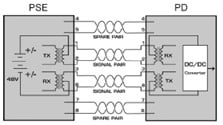
Type 1 and Type 2 Alternative A PoE delivers power over Pairs 1-2 and 3-6 simultaneously with data for both two- and four-pair applications.
Alternative B delivers power over spare pairs 4-5 and 7-8.
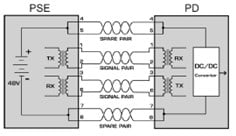
Type 1 and Type 2 Alternative B PoE delivers power over spare Pairs 4-5 and 7-8 for two-pair applications.
While Alternative A is compatible with two-pair applications like 10/100BASE-T and four-pair applications like 1000BASE-T, Alternative B is only compatible with data signals that use two pairs.
The latest 802.3bt standard for PoE includes Type 3 and Type 4, both of which now deliver power simultaneously with data over all four pairs, as shown below. Referred to as four pair PoE or 4PPoE, Type 3 PoE delivers up to 60 W, with 51 W available for the device. Type 4 delivers up to 90 W, with 71 W available for the device.
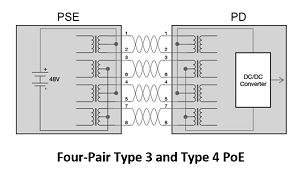
Type 3 and Type 4 Four Pair PoE delivers power over all four pairs simultaneously with data for both two- and four-pair applications.
What Are the Different Classes of PoE?
Because PDs have varying power requirements, IEEE 802.3 PoE standards and types are categorized into eight different classes, as shown in the table below.
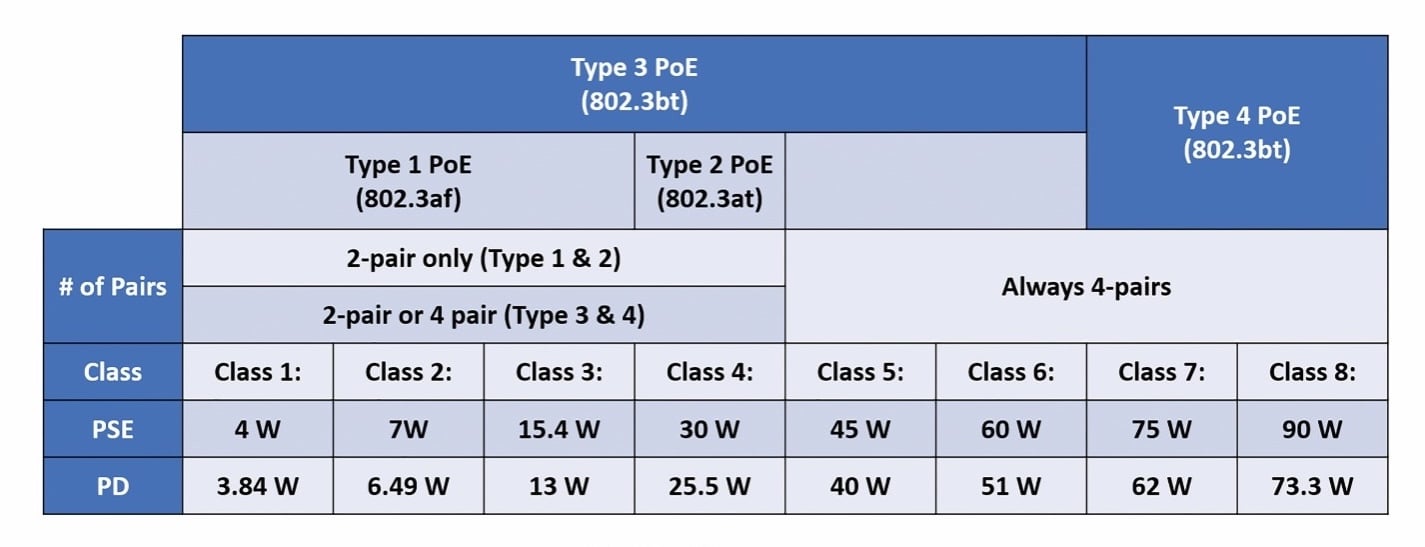
PoE Classes by type and applicable standard.
To enhance interoperability, the Ethernet Alliance — a consortium of manufacturers representing providers of PSE switching equipment — developed a PoE Certification Program. This program provides a methodology for manufacturers to certify their products for interoperability with other IEEE-802.3-based PoE solutions and gives simple labeling of such products.
Certification of the products is done according to a 300-page test plan using approved equipment. This may be conducted by manufacturers or by third parties, such as the University of New Hampshire’s Interoperability Laboratory (UNH-IOL). Both PSE and PD equipment may be certified. Equipment that passes this rigorous process may be labeled with the EA-approved marks shown below. Designers or installers of PoE equipment can simply compare the marks on the PSE and PD to determine compatibility. If the rating of the PSE is equal to or higher than the requirements of the PD, functionality is assured.
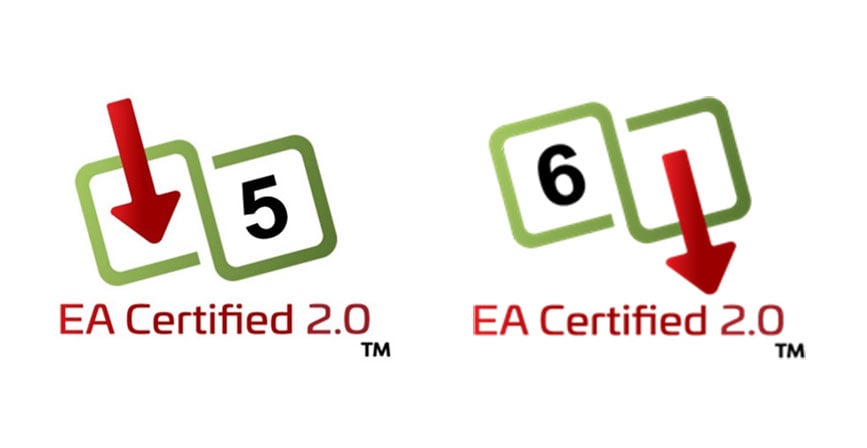
Ethernet Alliance marks for Powered Devices (left) and Power Sourcing Equipment (right).
What Are the Cabling Requirements for PoE?
In Type 1 and Type 2 PoE using Alternative A, power is transmitted by applying a common-mode voltage on the two pairs — meaning the current is evenly split between the two conductors, as shown below.
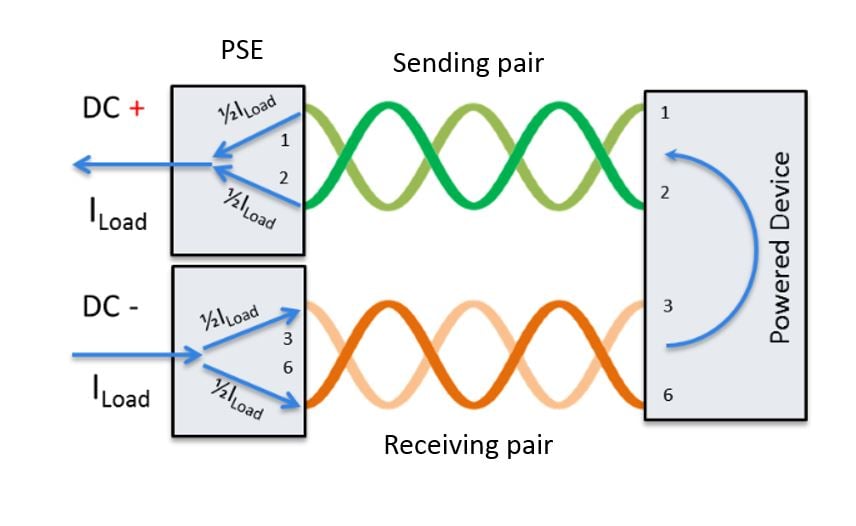
Type 1 and Type 2 PoE using Alternative A splits power equally on each conductor of a pair.
To achieve common mode, the DC resistance of each conductor in the pair must be balanced (equal). Any difference is referred to as DC resistance unbalance. Too much unbalance can distort data signals, causing bit errors, retransmits, and even nonfunctioning data links.
Like Type 1 and Type 2 PoE Alternative A, four pair Type 3 and Type 4 PoE also deliver power via common-mode voltage, so DC resistance unbalance matters here as well. However, in Type 3 and Type 4, it is no longer just the DC resistance unbalance on each pair you need to worry about. Excessive DC resistance unbalance between multiple pairs can also wreak havoc on data transmission and cause PoE to stop working.
While inferior quality cable with variations in conductor diameter and concentricity (roundness) are at a higher risk of DC resistance unbalance, inconsistent terminations where individual conductors are not correctly and consistently seated within IDCs can also cause DC resistance unbalance. So, while you may see a DC resistance unbalance specification on a vendor’s cable, field testing is really the only way to ensure DC resistance unbalance performance after installation. Testing for DC resistance unbalance within a pair and between pairs has become critical as more enterprise entities deploy devices that combine PoE and multiple Gigabit Ethernet transmission, such as 802.11 WAPs.
Heat Rise and Limited Power Cabling
Unfortunately, DC resistance unbalance isn’t your only concern here. When PoE is delivered over twisted pair copper cabling, increased temperature within the cable can increase insertion loss. This can cause a channel to fail insertion loss testing or require you to reduce the length of the cable.
The heat generated by PoE is even more of an issue when multiple cables delivering PoE are together in a tight bundle — the higher the power, the greater the heat. The NEC specifies the number of cables allowed in a bundle based on conductor size and temperature rating for Type 3 PoE (60 W) or higher. For these cases, the NEC includes ampacity tables that specify the maximum ampacity allowed for a specific cable bundle size, conductor gauge, and cable temperature rating installed at an ambient temperature of 30 °C (86 °F). The Telecommunications Industry Association (TIA) also provides guidelines for limiting temperature rise in a bundle within ANSI/TIA-568 cabling infrastructure standards.
Following a fact-finding study that investigated the effects of higher levels of PoE applied over cables in a bundle, Underwriter’s Laboratories (UL) introduced a Limited Power (LP) Certification to help simplify cable choice for PoE applications. The LP certification indicates that a cable has been validated to carry PoE under worst-case installation scenarios without exceeding the cable’s temperature rating. The certification accounts for large bundle sizes, high ambient temperatures, and other environmental effects such as enclosed spaces or conduits.
It’s important to understand that LP is a certification, not a listing or a rating. Unlike other UL listings or plenum or riser ratings required by the NEC, LP-certified cable is an option, not a requirement. Because the NEC is law, complying with ampacity tables is required; however, the NEC allows use of an LP-certified cable as an alternative to following the ampacity tables.
The good news is that you only need to worry about heat rise issues if you’re planning to run PoE above 60 W (Type 3). Many PoE-enabled devices, including surveillance cameras, require less than that. The bad news is that you never really know how much power might eventually be delivered over the cable to support future devices. Following ampacity tables or using LP-certified cable is a good method for future proofing your system. Other options include using cables with larger diameter conductors, higher temperature ratings, or shielded construction, as well as simply choosing not to use cable bundles.
While DC resistance unbalance is not typically an issue in higher-quality cables with a higher temperature rating or LP certification, poor workmanship can still cause too much resistance unbalance. Therefore, it’s still recommended that LP cabling be tested for DC resistance.
How Is PoE Tested?
As previously mentioned, testing for DC resistance unbalance within a pair and between pairs can ensure that an installed cable plant will perform in two- and four-pair PoE applications.
The Fluke Networks DSX CableAnalyzer™ Series of copper cable certifiers can quickly and easily test DC resistance unbalance within a pair and between pairs. This is achieved by choosing a test limit with a +PoE suffix, which is an option at the bottom of the DSX CableAnalyzer Test Limits screen. Selecting +PoE adds measurements for DC Resistance Unbalance within a pair, DC Resistance Unbalance between pairs, and DC Loop Resistance to the typical testing parameters required for certifying a permanent link to industry standards (for example, insertion loss, NEXT, PSNEXT, ACR-N, PSACR-N, ACR-F, PSACR-F and return loss).
As shown below, the DSX CableAnalyzer measures DC loop resistance as a sum of the resistance of two conductors in a pair, as well as DC resistance unbalance (the measure of the difference in resistance between the two conductors). As required for Type 3 and Type 4 PoE, it also measures the DC resistance unbalance between pairs. The following graphic shows that conductor-to-conductor DC resistance unbalance failed for Pair 1-2 but passed for pair-to-pair DC resistance unbalance.
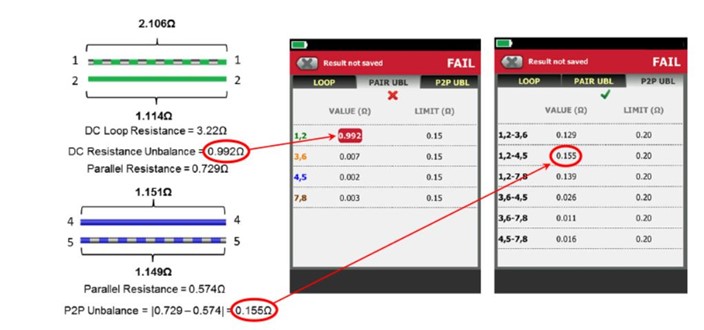
Choosing the Right Tester for PoE Troubleshooting
PoE systems can run into issues even with a properly certified cabling plant. Maybe the cable has been mislabeled, broken, connected to the wrong port, or disconnected entirely. Or perhaps the PoE switch is not configured to deliver adequate power. Troubleshooting these problems can take hours if you can’t see what’s on the wire. Then, you must trace the wire to find out if it’s okay and where it’s connected. And even if you figure that out, you can’t tell by looking at the switch if the power is configured correctly, so you’ll need to contact IT to figure out what’s going on. Choosing the right PoE tester can go a long way to ease the troubleshooting process.
Fluke Networks has developed two tools to solve these problems and save you hours of frustration: the LinkIQ™ Cable+Network Tester and the MicroScanner™ Cable Verifier. Simply plug either tool into the cable; if it’s connected to a PSE, it will display the class (0-8) of power available on the link. You can then compare that to the requirements of the PD and know if sufficient power will be available.
These testers are invaluable in many other ways, too.
- • They will identify port speed up to 10 Gbps. A slow port may limit the performance of a WAP or camera.
- • If the cable has been damaged, these testers display the length of each pair, potential breaks, or other failures.
- • These testers can function as a tone source for tracing the cable. Identifiers can be connected to remote cables to determine where the cables go, which is ideal when cables get unplugged or misrouted.
Both testers are certified under the Ethernet Alliance’s Gen2 PoE Certification program, so you can have confidence that it will work properly with all IEEE-compliant devices. They are also designed to work with a wide variety of non-IEEE-compliant technologies — but since there’s no certification program for that, you can rely on our expertise.
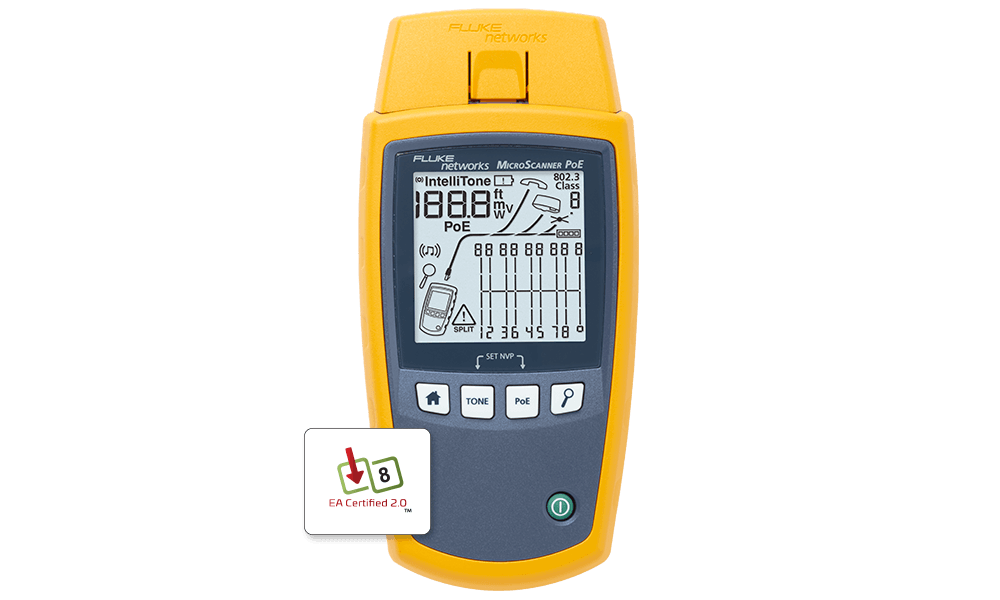
The Fluke Networks MicroScanner Cable Verifier is Ethernet Alliance Gen2 PoE certified.
LinkIQ takes troubleshooting PoE one step further by placing a load on the PSE to determine if the switch and cabling link are capable of delivering the advertised power. To test PoE load, LinkIQ can receive discovery protocol packets — such as the standards-based link layer discovery protocol (LLDP) or Cisco discovery protocol (CPD) — from a switch, which allows switches to discover connected devices and advertise their capabilities.
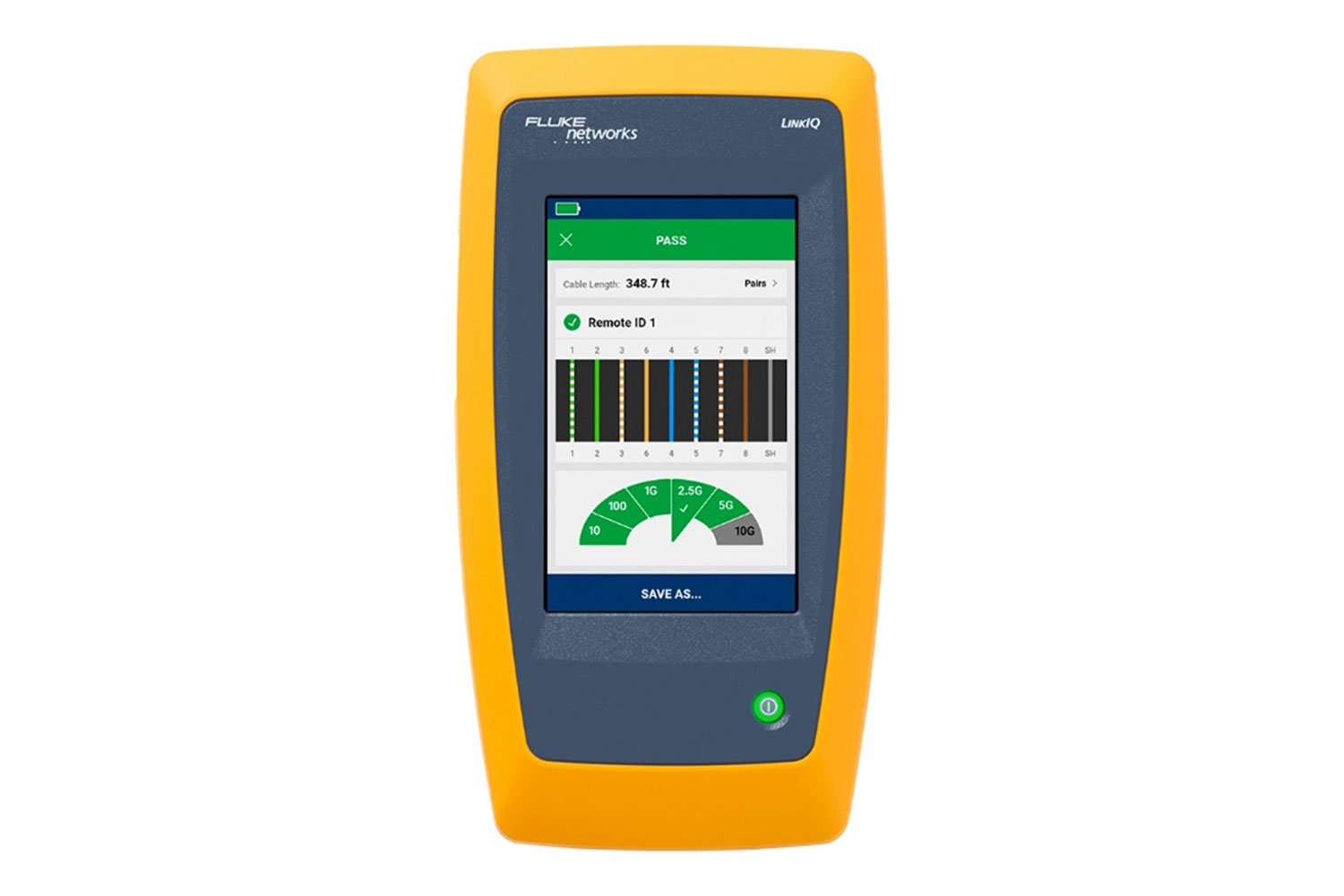
As a PoE load tester, LinkIQ shows which pairs carry power, the negotiated power class (0-8), and the loaded power in watts provided by the PSE at the device. It also shows the minimum required volts that the device needs to meet under load, and the actual measured volts under load to ensure it meets that requirement. Power negotiation between the PSE and PD occurs at both the hardware and software levels to ensure that a device can connect to the network and allow for dynamic allocation by the PoE switch. LinkIQ shows information for both the hardware and software classes.
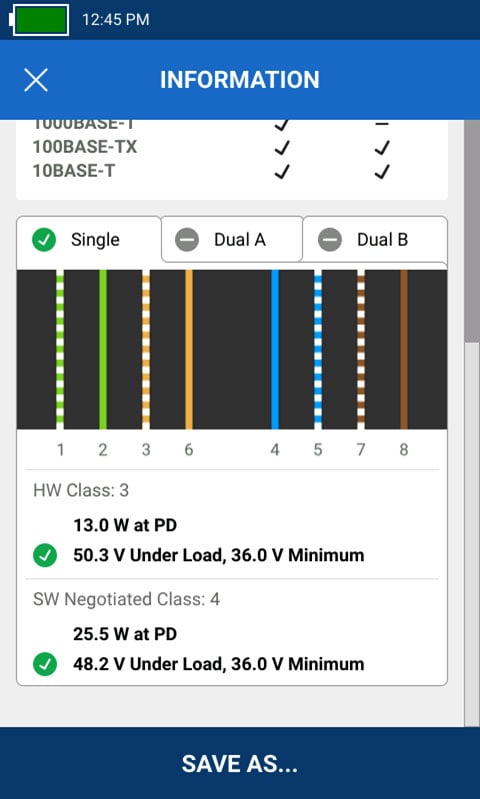
LinkIQ enables PoE load testing based on the negotiated power class and actual load for both hardware and software.
LinkIQ offers additional useful features. It characterizes the cabling performance up to 10 Gbps, displaying a connected switch’s name, port, and VLAN number. And it can generate reports for the cabling or the switch, and then store or print them using our popular LinkWare™ PC software.
With the right PoE test equipment and testing strategy, you can certify that your installed cable plants can support PoE, as well as check and troubleshoot installed PoE systems — ensuring that all your PoE projects go smoothly.
Keep Learning
- • What You Need to Know to Choose a PoE Tester
- • PoE Load Testing: Advanced Troubleshooting for Your PoE Systems
- • How to Test if Your Ethernet Cables Support PoE
- • What is (+All) and When Should I Choose It?
- • To Bundle or Not Bundle?
- • White Paper: DC Resistance Unbalance Testing: Easy, Low-Cost Insurance for Your PoE Systems



